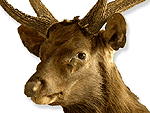Taxidermy
Australia has world champions in many fields, but some receive more recognition than others. For example few people are aware that at the 1999 World Taxidermy Championships held in Illinois, USA, Australian Gary Pegg won ‘Best in World’ with his rendering of a black cockatoo. In fact, Australians are now regarded internationally as very skilful taxidermists.
What is taxidermy?
The word taxidermy is derived from two Ancient Greek words, taxis meaning movement and derma meaning skin. Loosely translated the word means movement of skin, and it’s a general term describing the lifelike three-dimensional representation of an animal for permanent display. Most taxidermy procedures involve removing the natural skin from the specimen and placing it over an artificial body. In other cases the specimen is reproduced completely with man-made materials.
Gary Pegg works with animals of all shapes and sizes, including lions, bears, wart-hogs, deer, crocodiles and buffalo. The process normally involves gluing the leather or skin over a model made from polyurethane, and attaching handmade glass eyes. According to Gary fish and birds are the most complicated subjects to mount, and the strangest request he has ever had came from a lady who wanted her pet jellyfish stuffed!
Costs
To mount a game head costs between $400-$1300, while a full size animal might cost anywhere from $2000 to $4000, depending on the base and habitat.
Contact information
Australian Taxidermists’ Association
President: Gary Pegg
South Pacific Taxidermy Pty Ltd
39 Nevin Drive
Thomastown, VIC
Phone: (03) 9466 2687, Fax: (03) 9465 2022



